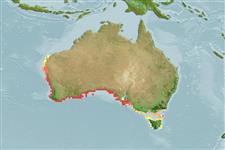>
Gobiesociformes (Clingfishes) >
Gobiesocidae (Clingfishes and singleslits) > Cheilobranchinae
Etymology: Alabes: Greek, alabes, oy = a fish from the Nile, dealing with lampreys (Ref. 45335); occidentalis: Named for its western distribution.
Environment: milieu / climate zone / depth range / distribution range
Ecología
marino demersal; rango de profundidad 1 - 4 m (Ref. 56640). Subtropical
Eastern Indian Ocean: Australia.
Tamaño / Peso / Age
Maturity: Lm ? range ? - ? cm
Max length : 4.0 cm SL macho / no sexado; (Ref. 56640)
Short description
Claves de identificación | Morfología | Morfometría
Diagnosis: It differs from its congeners with its elongate transparent body (depth 9.1-15.9 in SL). Very small gill slit (5.4 -17.5 in HL). Rudimentary pelvic fin absent. Postocular pore 1, anterior nasal pore present, posterior nasal pore absent. Lacrymal pores none. Vertebrae total 65-69, precaudal 16-17; last epineural on the 15th -17th vertebra. Caudal rays 4-6. Gut extension short. Tail length long. Dorsal origin over the anus. Unique color pattern in adult male (tiger-like brownish orange bars anteriorly on side of body, darker ventrally). This species is very similar to A. parvula, differing in the shape of the posterior portion of the gut (shorter and more rounded in parvula when viewed laterally in freshly caught material), lack of lacrymal pores (vs. usually present in parvula), and in coloration of the adult male (Ref. 56640).
Inhabits seagrass beds (Ref. 56640).
Life cycle and mating behavior
Madurez | Reproducción | Puesta | Huevos | Fecundidad | Larva
Hutchins, J.B. and S. Morrison, 2004. Five new species of the genus Alabes (Gobiesocidae: Cheilobranchinae). Rec. Australian Mus. 56:147-158. (Ref. 56640)
IUCN Red List Status (Ref. 130435: Version 2024-1)
Threat to humans
Harmless
Human uses
Herramientas
Special reports
Download XML
Fuentes de Internet
Estimates based on models
Preferred temperature (Ref.
123201): 15.8 - 21.9, mean 18 °C (based on 120 cells).
Phylogenetic diversity index (Ref.
82804): PD
50 = 0.5005 [Uniqueness, from 0.5 = low to 2.0 = high].
Bayesian length-weight: a=0.00102 (0.00046 - 0.00225), b=3.06 (2.88 - 3.24), in cm total length, based on all LWR estimates for this body shape (Ref.
93245).
Nivel trófico (Ref.
69278): 3.2 ±0.3 se; based on size and trophs of closest relatives
Resiliencia (Ref.
120179): Alto, población duplicada en un tiempo mínimo inferior a 15 meses (Preliminary K or Fecundity.).
Fishing Vulnerability (Ref.
59153): Low vulnerability (10 of 100).
